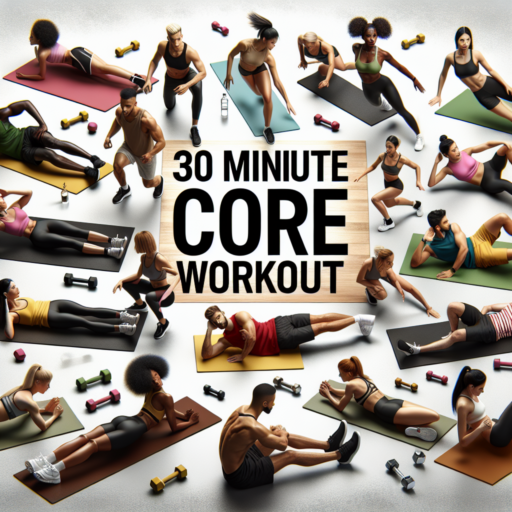Benefits of a 1 Hour Core Workout
Improves Postural Support
One significant benefit of a 1-hour core workout is the enhancement of postural support. Strengthening the muscles around your trunk and pelvis, primarily through core exercises, directly contributes to a more stable and upright posture. This improvement is vital for reducing the risk of back pain, which is often a result of weak core muscles and poor posture.
Enhances Athletic Performance
For athletes and fitness enthusiasts, the core is often referred to as the ‘powerhouse’ of the body. A strong core enables efficient transfer of energy from the center of the body to the limbs, thereby improving athletic performance across various sports and physical activities. Moreover, engaging in core workouts for just one hour can significantly enhance one’s balance, agility, and overall sports performance, making the exercises invaluable for athletes.
Boosts Daily Functioning
Beyond athletic capabilities, a solid core is essential for simpler, day-to-day activities and tasks. From bending to pick up groceries to twisting to reach or move objects, a strong core makes these movements easier and less susceptible to injury. Regularly dedicating time to core workouts ensures that your core muscles are well-prepared to support your body through any physical tasks, promoting a healthier, more active lifestyle.
Essential Equipment for Your Core Workout at Home
Having the right equipment can make a significant difference in the effectiveness of your core workout at home. Core training is crucial because it strengthens the muscles in your abdomen, back, and pelvis, which can improve stability, reduce the risk of injury, and enhance overall athletic performance. Investing in a few pieces of core workout equipment can help you achieve these benefits more efficiently and enjoyably.
Exercise Mat
An exercise mat is the foundation of a good home workout space, especially for core exercises. It provides the necessary cushioning for comfort and protection during floor exercises like planks, sit-ups, and leg raises. A high-quality mat with a non-slip surface will ensure safety and improve the effectiveness of your workout by allowing you to maintain proper form and alignment.
Stability Ball
A stability ball is a versatile piece of equipment that can enhance your core workout by introducing an element of instability that forces your abdominal muscles to work harder. Exercises such as ball crunches, planks on the ball, or ball bridges engage multiple muscle groups simultaneously, promoting strength and balance. Choosing the right size ball for your height is crucial to maintaining good form and maximizing the benefits of your workout.
Incorporating these essential pieces of equipment into your core workout routine at home can significantly improve your strength, stability, and overall fitness. By focusing on quality and versatility, you can create a home gym that supports a wide range of exercises tailored to strengthening your core muscles.
No se han encontrado productos.
Top 5 Exercises to Include in Your 1 Hour Core Routine
When constructing a 1-hour core workout routine, choosing exercises that target every aspect of your abdominal and lower back muscles is crucial for balanced strength and stability. These top 5 exercises have been handpicked to ensure your core workout is comprehensive, challenging, and capable of sculpting a strong, resilient midsection.
1. Planks
Starting with the basics, planks are a foundational core exercise that engages all major core muscle groups, including the rectus abdominis, obliques, and back muscles. Planks are versatile, with multiple variations to keep your core routine fresh and challenging. Ensure to maintain a straight line from your head to your heels for maximum benefit.
2. Russian Twists
For those aiming to target their obliques and achieve that sought-after V-taper, Russian Twists are indispensable. Incorporating this exercise into your routine not only helps in sculpting your side abs but also enhances rotational strength, which is essential for overall core stability and performance in various sports.
3. Bicycle Crunches
Bicycle Crunches are another excellent choice for a comprehensive core routine. This exercise targets the rectus abdominis and obliques simultaneously, making it an efficient movement for those limited on time. The dynamic nature of bicycle crunches also has the added benefit of raising your heart rate, contributing to calorie burn.
Modifying Your Core Workout for Beginners
Starting a core workout routine can seem daunting for beginners, but with the right modifications, it can become an achievable and rewarding part of your fitness journey. Modifying your core workout is essential not just for making the exercises manageable for beginners but also for ensuring proper form and reducing the risk of injury. Here, we will delve into simple yet effective ways to adjust your core exercises.
Firstly, it’s crucial to focus on the foundation. Instead of jumping into advanced movements, begin with the basics. For instance, modifying a standard plank by performing it on your knees instead of your toes can significantly reduce the strain on your core and back, making it more suitable for a beginner. This approach allows you to build strength gradually and safely.
Utilizing Props for Support
- Stability Balls: Using a stability ball for exercises like crunches can help engage more muscles and improve balance while offering support to your back.
- Resistance Bands: Incorporating resistance bands into your core workout can provide a gentle yet effective challenge, helping to build strength without overexertion.
Lastly, focusing on breath work is not only a modification but a fundamental part of any core workout, especially for beginners. Proper breathing techniques can help engage your core more deeply and enhance the effectiveness of each exercise. By exhaling deeply during the contraction phase of an exercise and inhaling during the release, you ensure your core muscles are actively engaged throughout the workout.
Advanced Techniques for a More Intense Core Workout
Exploring advanced techniques for bolstering your core workout can revolutionize your fitness journey. Incorporating complex moves and strategic modifications not only escalates the intensity of your workout but also enhances muscle engagement and strength gains. Emphasizing core stability and strength is crucial for overall fitness and athleticism, making these sophisticated methods a valuable asset in your exercise regimen.
Plank Variations play a pivotal role in intensifying your core workout. Transitioning from a traditional plank to more challenging versions such as the side plank with leg lifts or plank jacks can significantly increase core muscle engagement. These variations introduce an unstable element, compelling your core muscles to work harder to maintain balance, thus fostering improved core strength and endurance over time.
Dynamic Abdominal Exercises are another cornerstone of an advanced core workout. Incorporating movement into your core exercises, such as with bicycle crunches or Russian twists, adds a layer of complexity that challenges your core muscles further. These exercises not only target your abs but also engage the surrounding stabilizing muscles, offering a comprehensive core strengthening session.
Understanding Core Muscles and Their Importance
The core muscles, often referred to as the powerhouse of the body, play a pivotal role in our physical health and overall wellness. This group of muscles encircles the torso and includes the abdominals, back muscles, and the pelvic floor. They serve as the central link connecting your upper and lower body, ensuring that the body operates as a cohesive unit. The strength and stability of the core are crucial not only for athletes but for everyone, influencing posture, balance, and the ability to perform daily activities efficiently.
One of the key functions of the core muscles is to maintain proper posture. A strong core supports the spine, helping to prevent back pain—a common issue affecting a majority of the adult population at some point in their lives. This muscular support is essential for reducing the wear and tear on the spine, mitigating the risk of debilitating back injuries. Stable core muscles are also instrumental in enhancing balance and stability, which can prevent falls and injuries, especially in older adults.
Furthermore, the core muscles play a significant role in everyday activities, from bending to pick up a pen to twisting to reach the backseat of a car. They are also fundamental in performing more complex movements required in various sports, such as swinging a golf club or tennis racket. Thus, strengthening the core can lead to improvements not only in athletic performance but also in the ease with which daily tasks are performed.
Engaging in regular core-strengthening exercises is, therefore, beneficial for maintaining a robust and resilient body. This emphasis on core stability and strength can help reduce the incidence of injuries, enhance mobility, and improve the quality of life. Recognizing the central role these muscles play in health and functionality highlights the importance of including core exercises in a well-rounded fitness routine.
How to Keep Your Core Workout Safe and Effective
Keeping your core workout routine both safe and effective is crucial for achieving your fitness goals while minimizing the risk of injury. Core exercises not only enhance your stability and balance but also play a pivotal role in your overall physical strength. Here, we delve into essential strategies to ensure your core workouts serve their purpose without compromising your safety.
Understanding Proper Form and Technique
Maintaining proper form and technique is foundational to performing safe and effective core exercises. Incorrect posture or misalignment can lead to strain and injury, especially in the lower back area. It’s advised to start under the guidance of a professional who can correct your posture and provide modifications to suit your fitness level. Additionally, engaging in a gradual learning process by starting with basic exercises and progressively increasing difficulty can help in mastering advanced movements safely.
Incorporate a Balanced Core Workout Routine
A balanced core workout routine involves targeting all core muscle groups rather than focusing on one area. This holistic approach prevents muscle imbalances that could lead to instability and injury. Incorporating a variety of exercises such as planks, sit-ups, and oblique twists can ensure a comprehensive core strengthening strategy. Furthermore, balancing core workouts with adequate rest periods is essential for muscle recovery and growth, enhancing your workout’s effectiveness.
By focusing on mastering proper form, ensuring a balanced workout, and integrating these practices consistently into your fitness regime, you can enjoy the benefits of a strong, stable core without the setback of injuries. Implementing these strategies will help you maintain a core workout that is both safe and highly effective, contributing to your overall fitness and well-being.
Integrating Cardio into Your Core Workout for Maximum Efficiency
Many fitness enthusiasts often look for ways to enhance their workout routines for better results in a shorter amount of time. Integrating cardio exercises into your core workout is a strategy that promises increased efficiency and dual benefits. By doing so, you not only streamline your workout routine but also ensure that you are getting a comprehensive workout that targets both stamina and strength. This juxtaposition of cardio and core training creates a synergistic effect, elevating your fitness game to new heights.
One of the paramount benefits of combining cardio with core exercises is the improvement of your overall heart health while simultaneously fortifying your central body strength. This combination facilitates a higher calorie burn because it keeps your heart rate elevated throughout your core exercises. For instance, incorporating short bursts of high-intensity cardio like jumping jacks or mountain climbers between sets of planks or Russian twists can significantly enhance your metabolic rate during and after your workout.
Moreover, this approach aids in improving your endurance and stamina, which are critical components for any fitness regimen. By integrating cardio into your core training, you’re essentially training your body to be more efficient at oxygen utilization, which in turn, enhances your ability to perform both cardio and strength-based tasks for longer durations without fatigue. It’s a holistic approach that not only boosts your physical capabilities but also your workout motivation, by keeping your routines dynamic and engaging.
Weekly Core Workout Schedule for Optimal Results
When it comes to enhancing your core strength, consistency and variety are key. A well-planned weekly core workout schedule can significantly improve your muscle tone, balance, and overall fitness. Dedicating specific days to target different aspects of your core can lead to optimal results and prevent workout boredom.
Monday can be focused on stability and endurance, incorporating planks and leg raises. These exercises lay the foundation for a stronger core by engaging a wide range of muscles and improving overall endurance. Wednesday, might shift towards dynamic movements like Russian twists and bicycle crunches, targeting rotational strength and agility. These mid-week exercises are crucial for developing a responsive and flexible core. Finally, Friday can emphasize power, with exercises such as medicine ball slams and heavy kettlebell swings. This day helps in boosting explosive strength and incorporates the full body, nurturing a solid and resilient core.
Variety not only keeps your workouts engaging but also challenges your muscles in different ways, promoting more balanced, comprehensive strength development. Adding exercises like side planks on Tuesday and Thursday for oblique strengths and a rest or active recovery day ensures your body has time to repair and strengthen. Remember, the key to a successful core workout schedule lies not just in the exercises chosen but also in the consistency with which you approach your routine. Integrating core workouts into your weekly schedule helps to build a solid fitness foundation and brings you closer to achieving your health and body composition goals.
Tips for Staying Motivated with Your Core Workout Regimen
Staying motivated throughout your core workout regimen is crucial for achieving the desired results. It’s easy to start with high enthusiasm, only to find yourself struggling with maintaining the momentum over time. However, with the right strategies, keeping the fire alive for your core workouts can be less challenging and more rewarding.
Create a Realistic Schedule
One of the most effective ways to stay motivated is by creating a workout schedule that is realistic and manageable. Overloading your routine with intense workouts every day can lead to burnout and a decrease in motivation. Instead, aim for a balanced schedule that includes adequate rest days to allow your body to recover. This not only prevents physical exhaustion but also keeps your mental spirits high for the next session.
Set Achievable Goals
Setting achievable goals plays a vital role in maintaining motivation. Begin with small, attainable milestones, such as improving your plank time by 30 seconds or doing one more set of crunches than the last session. These minor victories keep you motivated, creating a sense of achievement that fuels your desire to push for more challenging goals. Remember, every little progress counts and serves as a stepping stone to reaching your ultimate core strength objectives.
Mix It Up
Boredom can quickly extinguish your motivation to continue with your core workout regimen. To combat this, integrate variety into your exercises. Experiment with different core workouts, such as pilates, yoga, or stability ball exercises, to challenge your muscles in new ways. This not only helps in preventing a plateau in your performance but also keeps the training exciting and engaging. Moreover, mixing up your routine reduces the risk of repetitive strain injuries, keeping your journey towards a stronger core safe and enjoyable.




